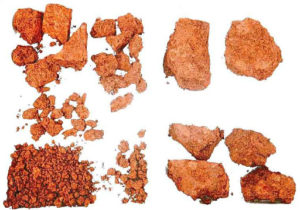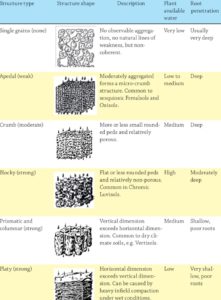Published January 20, 2021 | By Mike Petersen
When it comes to the health of the soil, the general consensus is all about the upper 10cm or 4inches. Haney Tests, the usual 20cm (8inch) soil tests from those who offer nutritional analyses of your soil in a grid fashion or shot gun scatter approach which is not very meaningful, all focus on the surface layer of your soils. Do your roots remain in the upper 4 inches the entire lifespan of your crop? Well you hope not because the plant would fall over and yield something ugly. For example, roots of a corn plant will reach 48 inches (122cm) quite regularly. That is over 10 times deeper than 4 inches and there are a good deal of items the soil profile has for you in those next 44 inches. So I would like to provide you some extra clues on the Soil Structure concept of the latest three blogs I have posted.

FIG. 1: Image of different soil types, examples from New Zealand. Courtesy NZ Soils
Soil structure has been just a little of the conversation when it comes to health and soil quality of soils, in fact woefully not thought of in the Soil Health topic and that is a shame. Structure of soils adds so much to complete the topic of Soil Health. The conversation circles around soil organic matter and biology – tool little is brought to the forefront with soil structure. Soils that have a structureless form have all kinds of negative connotations for water movement, root development, gas exchange, soil erosivity, and the biggie – soil compaction.
In the image to your left, the upper right side depicts massive or structureless form. Soil porosity is usually horrible to non existent. When soil horizons below the soil surface exhibit massive conditions we have to assume soils have been abused, crushed, beaten, sliced, mashed and overall in tough shape. Some soils that were under glacial ice for so long at a great thickness we can find this kind of form. A tough and serious issue. There are remedies but all of them take a good deal of time to help.
Soil Structure refers to the arrangement of soil separates into units called soil aggregates. An aggregate possesses solids and pore space. Aggregates are separated by planes of weakness and are dominated by clay particles. Silt and fine sand particles may also be part of an aggregate. The aggregate acts like a larger silt or sand particle depending upon its size.
The arrangement of soil aggregates into different forms gives a soil its structure. The natural processes that aid in forming aggregates are:

1) wetting and drying,
2) freezing and thawing,
3) microbial activity that aids in the decay of organic matter,
4) activity of roots and soil animals, and
5) adsorbed cations.
As aggregates congregate together they take shape into Apedal to Crumb to Blocky and so on. Soils that have structural types below the surface layer that are blocky or prismatic or columnar are extremely strong and supportive to loading from above. The more vertical axis of the soil structural type the better water movement and root development deep into the soil profile. The soils that depict prismatic structure that can part down into blocky structure are fairly mature in age and have been subject to all the 5 items mentioned above. Gravity is a main factor in all structural unit formation. Along the vertical faces roots will adhere to the walls, soil organic matter will adhere deep into the subsoil horizons and provide carbon products and also nutrients which the roots and lateral root hairs will access.
When you read a soil profile description of a Marna silty clay loam in Iowa, or a Miami silt loam in Ohio, or a Holdrege silt loam in Nebraska as a few to name off – one will see the horizon designations as Ap, Bw1, Bw2, Bt and so on then words like ‘weak moderate subangular blocky structure’ follow behind that which informs the reader what the soil structure is in a Bw horizon. Soil scientists that mapped and classified soils for the United States Soil Survey program of the USDA-SCS/NRCS do this in the field all the time. I know, I mapped soils in three states in my first career with the USDA.
Soil structure of a decently managed conservation tillage program, sound residue covers left on the surface for as much of the entire year as possible and within the cropping portion of the year will provide for good soil structure. Start moldboard plowing, deep subsoiling (>38cm) 15 inches and deeper and structure takes a beating and takes quite some time to reform, usually in terms of tens to hundreds of years. Soils in humid, warm all year along have very mature structure types like in Central America.
FIG. 2. Definitions of soil structural types
What does this have to do with me and my soils on my farm or parents place?
A great deal I say. Having some idea of the horizons in your fields per soil mapping unit in field 11 or field 3 and this can provide you knowledge how they respond differently is partly due to the soil structural types and how well water is absorbed then released to the plants we grow. I have already written about soil pores and porosity in a previous blog which you can revert to. The more moderate to strong soil structural units the better movement of water and gases in and out of the soil profile. When soils are platy which you may have noticed in Figure 2 near the bottom, roots, water movement is all tortuous and slowed dramatically. Usually in overly tilled soils, it is there due to tillage tools scraping, sliding, smearing on a plane creating layers like separate pages stacked on top of one another. I am sure many of you know this already, I applaud you for understanding these features of the soil profile. To further breakdown the idea of soil structure: when the horizons are indicated that it is weak in definition the trend is either the soil is quite young in age or the structure type of subangular blocky is being degraded by abiotic conditions usually. What does that mean – man is messing with wrong kinds and timing of over-tillage practices. As I mentioned earlier, when soils are described as massive or structureless – we soils guys or gals have observed degradation at its finest or it is a very immature soil profile. Do not assume soils with these types of structureless conditions are young and may get better with time.
The soil survey of the county or parrish you live in has all this information as you turn from page to page. If you have the opportunity to gain access to a day with a soil scientist to explain what you have is good stuff for you to improve upon your soil management techniques, understand the Soil Health or Soil Quality issues and provide you a service soils people love to talk about.